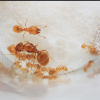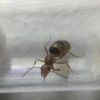- Formiculture.com
- Forums
- Gallery
- Members
- Member Map
- Chat

Interval Time Suggestion for Blacklight
Started By
CatsnAnts
, Jun 17 2022 11:50 AM
4 replies to this topic
#1
 Offline
-
Posted June 17 2022 - 11:50 AM
Offline
-
Posted June 17 2022 - 11:50 AM
Okay, I’m going to do my best to explain this, so bear with me:
I made a black light trap last year that involved two trays of water and a blacklight. Bugs would land in the water while the blacklight stayed on all night, and I could check the trap in the morning. However, most (if not all) of the hundreds of queens I caught last year turned out to be not mated, and I blame this on my blacklight being as bright as the damn sun.
So, in order to combat this, I want to give the queens time to mate. I ordered a plug-timer that allows for my blacklight to turn on at 8:00 pm and off at 8:00 am. It ALSO allows for me to set an interval on/off routine for that time frame, such as 10 seconds on and 20 seconds off (repeatedly, all night). The key is that when the light is off, queens will have time to mate, and then for the short time frame that it is on every so often, the queens will still go to the blacklight.
My question: What would be the best interval for a setup like this (ex. 12 seconds on for every 30 seconds off, repeat from 8:00 pm to 8:00 am)?
I made a black light trap last year that involved two trays of water and a blacklight. Bugs would land in the water while the blacklight stayed on all night, and I could check the trap in the morning. However, most (if not all) of the hundreds of queens I caught last year turned out to be not mated, and I blame this on my blacklight being as bright as the damn sun.
So, in order to combat this, I want to give the queens time to mate. I ordered a plug-timer that allows for my blacklight to turn on at 8:00 pm and off at 8:00 am. It ALSO allows for me to set an interval on/off routine for that time frame, such as 10 seconds on and 20 seconds off (repeatedly, all night). The key is that when the light is off, queens will have time to mate, and then for the short time frame that it is on every so often, the queens will still go to the blacklight.
My question: What would be the best interval for a setup like this (ex. 12 seconds on for every 30 seconds off, repeat from 8:00 pm to 8:00 am)?
Spoiler
#2
 Offline
-
Posted June 17 2022 - 6:10 PM
Offline
-
Posted June 17 2022 - 6:10 PM
I’ve found that queens will mate right on the blacklight, and that turning it off doesn’t matter at all. In fact, this may cause the queens to start flying away as there is no longer any light to attract them.
- CatsnAnts and FloridaAnts like this
My journals:
Polyergus Mexicanus: https://www.formicul...gs/#entry175528
Lasius minutus: https://www.formicul...cs/#entry174811
Lasius latipes: https://www.formicul...gs/#entry206449
General acanthomyops journal: https://www.formicul...yops-with-eggs/
Polyergus Mexicanus: https://www.formicul...gs/#entry175528
Lasius minutus: https://www.formicul...cs/#entry174811
Lasius latipes: https://www.formicul...gs/#entry206449
General acanthomyops journal: https://www.formicul...yops-with-eggs/
#3
 Offline
-
Posted June 17 2022 - 7:02 PM
Offline
-
Posted June 17 2022 - 7:02 PM
I heard that some people only catch queens they caught mating in the black light, or only keep ones that shed their wings…. I think some of that is a little flawed…
- CatsnAnts likes this
#4
 Offline
-
Posted June 18 2022 - 9:19 AM
Offline
-
Posted June 18 2022 - 9:19 AM
I heard that some people only catch queens they caught mating in the black light, or only keep ones that shed their wings…. I think some of that is a little flawed…
True, that seems like a valid point. However, when my queens reach the blacklight, they will not be flying away due to the water (hence why it is a trap, which was mentioned briefly). If I could stay out at night, I would, but nightshift doesn’t allow for me to do that. I have no other explanation to why none of my queens were mated last year, so I figured this was my best bet to fix the problem. Also, having intervals for the light would mean that I trap less queens (less redundancy) and let more to be on their merry way instead of being stuck in water all night. So, back to my original question of what interval would be the best?I’ve found that queens will mate right on the blacklight, and that turning it off doesn’t matter at all. In fact, this may cause the queens to start flying away as there is no longer any light to attract them.
Edit: Basically, I have to make sure that the queens are mated before they reach my trap. They will not be able to mate any further when they are in the trap, so I’m trying to give them time in the air to do just that.
Edited by CatsnAnts, June 18 2022 - 9:48 AM.
- FloridaAnts likes this
Spoiler
#5
 Offline
-
Posted June 18 2022 - 9:59 AM
Offline
-
Posted June 18 2022 - 9:59 AM
I heard that some people only catch queens they caught mating in the black light, or only keep ones that shed their wings…. I think some of that is a little flawed…
True, that seems like a valid point. However, when my queens reach the blacklight, they will not be flying away due to the water (hence why it is a trap, which was mentioned briefly). If I could stay out at night, I would, but nightshift doesn’t allow for me to do that. I have no other explanation to why none of my queens were mated last year, so I figured this was my best bet to fix the problem. Also, having intervals for the light would mean that I trap less queens (less redundancy) and let more to be on their merry way instead of being stuck in water all night. So, back to my original question of what interval would be the best?I’ve found that queens will mate right on the blacklight, and that turning it off doesn’t matter at all. In fact, this may cause the queens to start flying away as there is no longer any light to attract them.
Edit: Basically, I have to make sure that the queens are mated before they reach my trap. They will not be able to mate any further when they are in the trap, so I’m trying to give them time in the air to do just that.
Before I actually started keeping ants, I would raise Lasius queens in a sand bucket. You may be asking, how does this relate? Well, the queens I caught in a pool, with males climbing on them. I could watch them mate, and often only found 8 or 9 a day, and keep in mind, this pool was screened in.
So, I think if you found a way to let the queens in the water, but get the males to use the queens as a raft, it would work.
Well, now that I think of it…
For queens that don’t mate mid-air, you could let them fly in the water, put a rock in it for them to climb onto to mate. Now, since their wings are wet and will not dry in the middle of the night, they can’t fly and the queens won’t be suffering too long. Sorry if this is dumb, just an idea.
- CatsnAnts likes this
1 user(s) are reading this topic
0 members, 1 guests, 0 anonymous users














